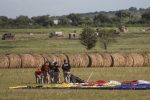Prairie Lea and Six-Man Football has long history
By Jess Stephens
The first official season of UIL six-man football in Texas was 1938. Prairie Lea played an integral role in this new UIL division.
For many years, the story was told that Prairie Lea vs. Martindale was the first six-man football game in the state of Texas. As with many other historical facts a century ago, many facts are determined by the person telling the story.
The History of Six-man Football – 90-years-old
On Sept. 26, 1934, in Hebron, Nebraska, a team comprised of boys from the Nebraska towns of Hardy and Chester, using the team name Hard-Chests, took on a team of boys from the Nebraska towns of Belvidere and Alexandria, which used the team name Bell-Alex.
Stephen Epler was the physical education teacher in Chester and is credited with inventing the game. Largely due to the effects of the Great Depression, Epler didn’t have enough boys to play 11-man football and convinced his superintendent to let him try it with just six players on each side. The superintendent obliged, and later that year, Hebron College allowed the schools to use their equipment and play the game on their field. Thousands came to watch that first game, with tickets sold for five cents and up to 25 cents for field side seats.
Epler produced his first handbook of rules in 1937 and revised it eight years later. Many of his initial rules are still followed in the modern game, including a field that is 80 yards in length, 15 yards needed for a first down, and one point for a conversion that is run into the end zone and two points for a conversion that is kicked after a touchdown.
On a side note, Epler is also credited with inventing the game of six-man baseball, which grabbed some national attention for a few years, but soon struck out and never made it to the masses.
After inventing six-man football, Epler went on to serve in the US Navy and spent the rest of his educational career as the superintendent, dean and president of many high schools and colleges on the west coast, including a founder of Portland State University and Ohlone College in Fremont, California. He was born in 1909 in Iowa and passed away at the age of 87 in Sacramento, California.
Prairie Lea versus Martindale — A myth worth holding on to
Granger Huntress, the founder and proprietor of sixmanfootball.com and considered by most to be the nation’s top six-man football guru, wrote on his site about this mythical matchup. His research included writer Carlton Stowers, and his article titled “Heroes in Hinterland” that was later cited in two books by C.H. Underwood, “Six-man Football” and “Texas Six-Man Football.” In his piece, Stowers interviewed Rodney Kidd years after he had served as the UIL State Director. Kidd was quoted, “We had a lot of small schools which were unable to field 11-man teams, but they had expressed a desire to play some kind of football.
“We contacted a couple of coaches at small schools, Prairie Lea and Martindale, in the spring and asked them if they would study the rules, practice for a while, and put on an exhibition game for us so that we might see what the game was all about.”
On May 5, 1938, the Lockhart Post-Register reported that Prairie Lea and other schools’ officials met with Rodney Kidd and Roy Bedichek in San Marcos to organize a “6-man football league” for schools in Hays and Guadalupe counties. J. D Fulton of Prairie Lea was elected district chairman and L. J. Wehmeyer of Prairie Lea was named secretary. The article noted that a second meeting would be arranged to make a schedule of games. However, there is no mention in any local papers or old yearbooks of the mythical Prairie Lea versus Martindale game in the summer of 1938.
Huntress concluded that Prairie Lea never played Martindale before six-man football was a UIL sport. Huntress and many other six-man scholars now concede that more than likely, Kidd had mistakenly confused the collaboration he had with Prairie Lea and Martindale and the exhibition game that he had two coaches put on for the state coaches meeting that summer.
Current Prairie Lea Athletic Director, Jess Stephens opined, “We must remember that facts can get in the way of a good story so, with Martindale no longer having a high school, Prairie Lea will gladly carry on the self-proclaimed title of first UIL Six-man Football school.”
Six-Man Football — the official sport of Rural Texas
Six-Man Football in Texas officially began as a UIL sport in 1938, with 55 teams and 9 districts.
Prairie Lea was in the first District 3 along with the following schools: Dale, Lytton Springs, Uhland, Martindale, Dripping Springs, Kyle, and Wimberly. Prairie Lea, Martindale and Dripping Springs all tied for the first district championship.
Local historian Patsy Kimball noted in 1939, the Prairie Lea Indians football team was generally recognized as the UIL champion of all South Texas. Team member Hans McCartney was selected by The American Boy as quarterback on the Six-Man All-American Team in recognition of his ability in scoring 162 points.
The little game that could has progressed over the years. Many notable players and teams came from the Texas game in the early years, including Jack Pardee (College Football Hall of Fame), Ed Sprinkle (Pro Football Hall of Fame), Ken Konz (NFL player) and Don Maynard (Pro Football Hall of Fame).
In the 1980’s and 90’s the game grew even more, and in 1995 brought about Dwayne Miles. After two state championships at Amherst, Miles went on to become the all-time leading rusher at West Texas State University (now West Texas A&M) and made it on to the Green Bay Packers practice squad. Many other Texas six-man football players have played on the college level since then and continue to now.
The game is about speed and. Every player on the field has to be fast and ready to make the tackle at the line or 40 yards upfield. As many points that are scored, defense is an even bigger part of the game.
Eleven-man football has 3 levels to stop a runner, while in six-man football, the defender knows that they have to make the tackle as there is usually no one else besides the one defender between the ball handler and the end zone.
Prairie Lea — Where are they now.
It is unknown why Prairie Lea put a pause on their football program, but from 1957 to 2004, the school did not field a football team. There were a couple of opportunities in the past ten years to make the playoffs, but as of today, Prairie Lea holds the state’s longest playoff drought at 75 years. The 1949 team won the district title that year, and it still stands as the last for Prairie Lea football.
This year’s team returns 5 starters on offense and 5 starters on defense and looks to break that streak during Coach Steven Brown’s third year as head coach of the Indians.

